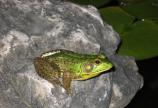Bullfrog research takes big leap forward

Bullfrogs—to most of us they’re just big, green, bug-eyed critters that hop and croak and (usually) make us laugh. They’re also invasive in some regions, including southern Vancouver Island.
But to scientists studying environmental health, bullfrogs are an ideal “sentinel” species for monitoring the effects of pollutants such as pesticides, drugs and industrial effluents.
That’s why there’s a lot of excitement in a UVic lab about a new project to become the first in the world to sequence the bullfrog’s complete set of genes, or genome.
Bullfrogs are “true frogs”, or ranids, a family of frogs that, because of their unique transformation from aquatic tadpole to terrestrial frog, have yielded key discoveries in many biological and medical fields. But progress in these fields has been hampered by the lack of a frog genome reference.
“We don’t know much about the bullfrog at the molecular level, and there is an emerging need to understand the changes in their DNA when they’re exposed to pollutants,” says UVic molecular biologist Dr. Caren Helbing. She’s working with Dr. Inan Birol at the Michael Smith Genome Sciences Centre on the 18-month project, which is being funded by $200,000 from Genome BC.
“Just as sequencing the human genome is revolutionizing medicine, generating a bullfrog genome will help us further understand the basis for disease and immunity, genetic biodiversity, response to environmental pollutants, and habitat and climate change.”
Frogs require clean habitats in water and on land, and have permeable skin that can easily absorb toxic chemicals. These traits make them particularly sensitive to environmental disturbances. They’re also a food source for other animals, so impacts on frogs have far-reaching ecological consequences.
Mapping the bullfrog genome will give scientists a baseline DNA reference for determining the genetic effects of various chemicals in the environment.
The bullfrog genome is about twice the size of the human genome, says Helbing. Her team of students and research staff will use advanced technology to generate millions of DNA sequences, and then piece them together like a jigsaw puzzle to form the complete genome. They’ll then identify where genes in this sequence are likely located.
“The low-cost methods we develop to do this will be directly applicable to other organisms with complex genomes,” she says.

